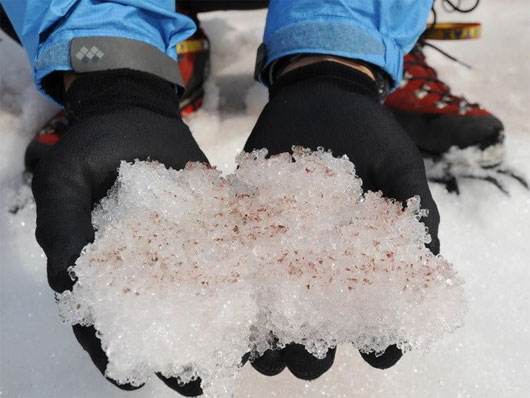The Arctic ice color is closely linked to climate change
A study published in the Journal of the National Academy of Sciences published on February 17, said the Arctic ice sheets are becoming less bright due to the fast melting situation associated with the Earth phenomenon. Warming.
This provides a closed cycle of climate change as the temperature of the Earth rises (for many reasons) causing the ice to melt quickly and the ice to melt down further worsening climate change.
By using satellite measurement, scientists from the California Institute of Oceanography conducted a measure of the light reflection of ice sheets into space, which showed that the ice layers were on the thinner and darker, 2 to 3 times more than previously predicted.

"Red snow" on the Greenland glacier in the Arctic.(Photo: Kyodo / TTXVN)
The study also showed that the darkness of the ice layers in the Arctic also increased by 8% compared to the period from 1979 and 2011.
Ian Eisenman, co-author of the study, explained that rapid melting of ice in the summer made the ice thinner and exposed the black waters of the ocean below. This causes the glacier's ability to reflect light, which means that the temperature of the Earth rises.
According to the principle of reflected stress (Albedo) , when the Sun shines on snow, the ice will reflect light and some of the heat will radiate into the air. The thicker the ice, the more white the color, the stronger the reflection level, even twice as strong as the thin ice layer and 10 times the water surface, and the more heat will be generated. Therefore, when the ice layer becomes thin or dissolves into water, the light reflection will decrease and the Earth will have to absorb more solar energy.
From scientific arguments attached to the above practice, experts come to the conclusion that melting and blackening Arctic ice is both a cause and a consequence of global warming . Arctic glaciers are melting at breakneck speeds, leading to rising sea levels, narrowing the habitat of these species and seriously affecting the lives of coastal people.
A study by the European Space Agency (ESA), published in October 2013, shows that the Arctic sea ice is continually decreasing in numbers and the ice layers here also become thinner than the others. another area.
- Climate change warms up the
- NOAA: Climate change in the Arctic is inevitable
- Summary of UN special report on climate change: The Arctic as we know it is gone, believe your eyes
- Will climate change change the color of autumn?
- The 6th China discovered the Arctic
- Giant Arctic mosquitoes thrive because of climate change
- The huge Soviet tunnel that dug into the Arctic is melting
- Other mating species makes white bears extinct
- Arctic ice is melting record fast
- Video: Dangerous germs hidden in Arctic ice are melting
- Huge warm water tank is
- Ice in the Arctic is likely to disappear by 2030
 Is the magnetic North Pole shift dangerous to humanity?
Is the magnetic North Pole shift dangerous to humanity? Washington legalizes the recycling of human bodies into fertilizer
Washington legalizes the recycling of human bodies into fertilizer Lightning stone - the mysterious guest
Lightning stone - the mysterious guest Stunned by the mysterious sunset, strange appearance
Stunned by the mysterious sunset, strange appearance Plan to build giant canopy over Antarctica has problems
Plan to build giant canopy over Antarctica has problems  Why does ice stick to your hands when you hold it?
Why does ice stick to your hands when you hold it?  NASA releases ice map on Mars
NASA releases ice map on Mars  After 389 days in the Arctic, costing more than $160 million, hundreds of scientists brought back bad news: What was it?
After 389 days in the Arctic, costing more than $160 million, hundreds of scientists brought back bad news: What was it?  650,000-year-old 'gateway to the underworld' discovered in Siberia
650,000-year-old 'gateway to the underworld' discovered in Siberia  How to explain the strange ice circle that rotates like a time-travel door?
How to explain the strange ice circle that rotates like a time-travel door? 